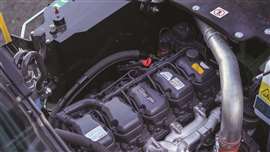Read this article in Français Deutsch Italiano Português Español
Hauling rocks with Rokbak
06 May 2024
North America is Rokbak’s largest market
 Rokbak RA30 (Photo: Rokbak)
Rokbak RA30 (Photo: Rokbak)
This summer marks the tenth anniversary of Volvo Group’s acquisition of the truck business from Terex Corp. The $160 million deal closed in June 2014 and included two truck categories as well as the factory in Motherwell, Scotland. Made part of Volvo Construction Equipment, the operation ran as Terex Trucks for several years thereafter. Then, in September 2021, the articulated trucks were rebranded as Rokbak.
The name “Rokbak” followed extensive research to find something that resonated with customers. The name draws inspiration from “rock trucks,” a popular nickname for that type of truck.
While changing the brand was always part of the plan, it is rarely an easy process. Rokbak Managing Director Paul Douglas said all the work that went into it has been worth it. “I couldn’t imagine how successful the name change would be. It wasn’t the first name out the box — there were many ideas,” he said. “Those were narrowed down to a select list. And then through diligence, looking at prior art, looking at copyright, looking at it legally and through various translations, Rokbak emerged as the cleanest of the five shortlisted names. The name implies it’s a ‘rock truck with a strong back,’ and that was appealing to us. Then we had to get our head around the change. When we saw the new colors of the truck and then the whole thing for the first time in metal, it was great. It really popped.”
 An RA40 in Western Canada. (Photo: Rokbak)
An RA40 in Western Canada. (Photo: Rokbak)
Building on success
Last fall, the brand said it recorded a 40% returning and 60% new business customer base in 2023. Overall, for North America, the largest market for that style of truck, Rokbak said approximately 60% of the machines that leave the factory head across the Atlantic. The company has 35 dealers in North America that operate around 90 locations. Unit sales have increased by 25% in Europe, the Middle East and Africa (EMEA). Mining, quarrying, urban infrastructure, highways and housing developments are some of the big sectors for Rokbak trucks. They’ve also been put to work moving wet concrete for airport runways and for snow removal.
The Motherwell operation has a long history of building trucks. It opened in 1950 as Euclid Great Britain and after shipping several thousand trucks was rebranded as Terex in 1968. Nine generations of TA articulated haulers had been produced there before it was acquired by Volvo Group. Today, Volvo Motherwell designs, develops, manufactures and supports two product ranges: Rokbak articulated haulers and Volvo rigid haul trucks.
Final assembly for Rokbak articulated dump trucks and Volvo rigid frame trucks takes place on dedicated production lines. “We’re quite unique within the Volvo family, as we are a dual-branded facility. We have people that are dedicated to one or the other of the brands, but we have a core team that support both. I’m on the core team that supports both,” said Douglas, “so I am equally at home having a conversation with a Volvo dealer who represents the Volvo rigid trucks or a Rokbak dealer.”
 Rokbak RA40 (Photo: Rokbak)
Rokbak RA40 (Photo: Rokbak)
New brand, new trucks
“The work has been deeper than the new brand,” said Douglas. “In the time since Volvo acquired the business, we’ve demonstrated that the changes and the investments we’ve made have improved the quality and the reliability of the truck. Today it’s a stronger, more reliable product. Our warranty levels are the lowest they’ve ever been. We are building on that new brand, with a stronger, more reliable truck and really good ownership from Volvo CE in a very strong market.”
Rokbak offers two models of articulated haulers, with payloads ranging from 30.9 to 41.9 tons (28 to 38 tonnes).
 The dash inside a Rokbak truck (Photo: Rokbak)
The dash inside a Rokbak truck (Photo: Rokbak)
The RA30 has a 30.9-ton capacity. It uses a Scania DC9 diesel engine rated 370 hp at 1,800 rpm and a torque output of 1,387 lb. ft. at 1,400 rpm. It is connected to a ZF 8EP320 fully automatic transmission that drives the truck’s heavy-duty axles. Each of the three axles are in permanent all-wheel drive. Out front there is a fully independent suspension developed in Ireland by Timoney Technology Ltd.
Engines for both trucks can be fitted with an immersion heater and thermostat for the engine cooling system, as well. The company said the immersion heater helps the engine get up to operating temperature, by preheating the engine before it is started. It reduces component wear and emissions by not having to idle while it gets up to temperature, and gets the truck out to work faster.
The RA40 is the largest Rokbak truck, with a capacity of 41.9 tons hauled within a welded body constructed with high-strength steel and a dual slope tailchute design that eases material ejection. It uses a Scania DC13 diesel engine rated 444 hp at 2,100 rpm that is connected to an Allison HD4560 fully automatic transmission.
 Rokbak’s articulated haulers use Scania diesel engines. (Photo: Rokbak)
Rokbak’s articulated haulers use Scania diesel engines. (Photo: Rokbak)
Both truck models get ground level service access, an electric-lift hood and tilting cab.
The operator of an RA40 gets a spacious, ergonomic cab with pressurized properties. Acoustic insulation helps minimize noise levels inside the cab, said the company, while an easily adjusted heating, ventilation and air conditioning system ensures a stable temperature. End-users also get a tilt/telescopic steering wheel, an air suspension seat with adjustable armrests, anti-vibration mounts on the engine and cab, and cushioned stops on the steering cylinders.
A full suite of on-dash diagnostic and machine health check data maximizes uptime, said Rokbak. This includes prognostics for the transmission so the operator can check fluid level, filter and clutch life and more.
Rokbak’s Haul Track telematics system helps owners manage total cost of ownership by keeping an eye on everything from fuel consumption to machine usage. The system gives customers live data viewable on desktop computers and mobile devices.
 Rokbak RA30 (Photo: Rokbak)
Rokbak RA30 (Photo: Rokbak)
Telematics in the field
As an example of how Haul Track is used, Rokbak shared the story of its dealer, GT Mid Atlantic (GTMA), which operates in Maryland, Delaware, New Jersey, Washington D.C., Philadelphia and northern Virginia and West Virginia.
The company has a rental fleet of around 600 machines, 74 of which are Rokbak articulated trucks. The dealer said Rokbak’s telematics system makes that task a little easier: at its New Jersey branch it set up a control area dubbed the “War Room” that’s dedicated to telematics monitoring.
 Telematics helps GTMA fix an issue before it becomes a problem. (Photo: Rokbak)
Telematics helps GTMA fix an issue before it becomes a problem. (Photo: Rokbak)
With data from the telematics system, the dealer can see the precise location of each truck within a specific fleet, track loads, calculate the hours worked as well as monitor speed and idle time.
“There are times when we’re aware a machine has a problem before the customer knows,” said Eric Marburger, GTMA vice-president and general manager – Maryland & Delaware. “When we go out to the site, we know exactly where the fault is. For example, it may be low fuel pressure, which means we’ll bring fuel filters with us so we’ve got the parts we need to fix the issue. Fundamentally telematics enables increased uptime and productivity for the customer and reduced travel time and mileage for us.”
Within the War Room a full-time telematics manager monitors multiple screens dedicated to each group of telematics. Each machine can be tracked anywhere that receives a satellite signal, with the truck’s location shooting up on screen with a red marker when there is an issue.
Haul Track hardware and a three-year activation is standard on all Rokbak Tier 4 Final trucks; hardware is standard on Stage 5 trucks. Haul Track uses the AEMP protocol, where data is presented in a standard format that follows ISO 15143-3. Output from Haul Track can integrate with other systems to enable mixed fleet management.
Future goals
As part of the Volvo Group, Rokbak’s long-term plans are aligned with the group’s sustainability values. This includes the Volvo Group target to reach net-zero greenhouse gas emissions by 2040. Rokbak has been reviewing solutions to help it achieve those goals. Its haulers are already built for low fuel consumption and global CO2 emissions compliance. The engines used in the RA30 and RA40 are compatible with hydrotreated vegetable oil (HVO) which the company said allows customers to reduce CO2 emissions by up to 90% pm a well-to-wheel basis.
“It’s been quite a journey and it’s great to be where we are right now, but we don’t stand still,” said Douglas. “That’s not in our nature and being part of Volvo, we are also part of its high ambitions.”
As part of the Volvo Group, Rokbak has ready access to technology developed by its parent companys.
“Volvo has a long history of being a multi-brand company and it’s comfortable with that. It recognizes the strength of keeping certain brands unique. The trucks are great examples: look at Renault and Mack, which are really strong brands in their own right, but under the skin they share a lot of technology. That’s the way we’re going, as well.”
Douglas’ background is in engineering. For the big trucks that leave Volvo Motherwell, he said he has his eye on hydrogen fuel cell or hydrogen internal combustion, with fuel such as HVO an important interim step.
“For smaller equipment, batteries are a great solution,” said Douglas. “Personally, I think the technology for the big stuff will be hydrogen. But it’s not just about OEMs like Volvo and Rokbak coming up with solutions. We need the infrastructure, and we need the governments in all of the countries and territories to be onboard, as well.
“Our customers and dealers are receptive to being part of that journey. They’re receptive to making sure we’re working towards a cleaner planet with equipment that puts out zero emissions. They get it. But for them, what’s unclear is how their current business model will work if it’s not with an internal combustion engine. But there is no downside to this technological shift, and I think the challenges will be solved.”
This article originally appeared in the March 2024 issue of Power Progress magazine.
 A Rokbak RA40 in Tennessee (Photo: Rokbak)
A Rokbak RA40 in Tennessee (Photo: Rokbak)
POWER SOURCING GUIDE
The trusted reference and buyer’s guide for 83 years
The original “desktop search engine,” guiding nearly 10,000 users in more than 90 countries it is the primary reference for specifications and details on all the components that go into engine systems.
Visit Now
STAY CONNECTED




Receive the information you need when you need it through our world-leading magazines, newsletters and daily briefings.
CONNECT WITH THE TEAM













